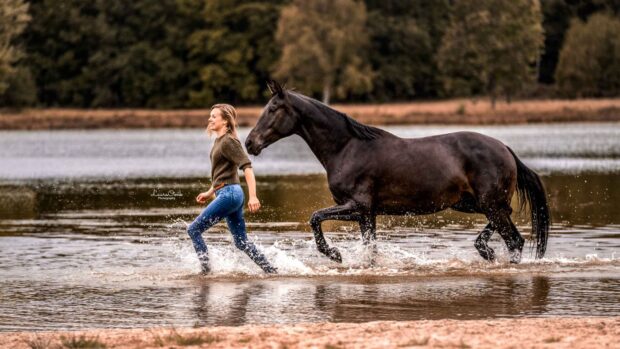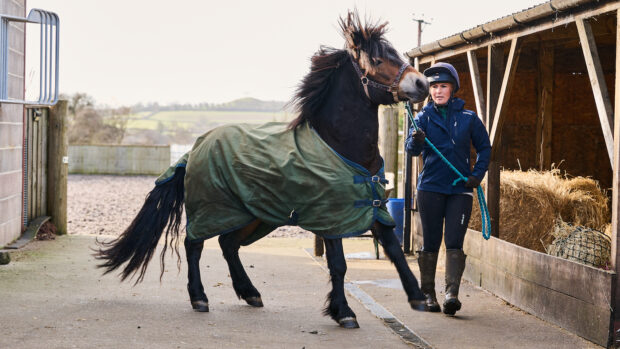What is long reining and when it is beneficial?
“Long reining has long been an integral part of the breaking-in process in terms of getting a horse used to the rein and voice aids and establishing the steering and brakes,” explains freelance rider and trainer Brendan Gallagher. “It also gives you the opportunity to expose a young horse to scenarios outside the arena, getting them more confident going on their own.”
Long reining is equally beneficial for older horses and those recovering from injury.
“You can long rein in straight lines, which is low stress and low intensity, and it is effectively like riding your horse but from the ground,” says Brendan. “You can use half-halts – a squeeze and release down the outside rein – and you can change the bend, ask for transitions and perform many shapes and movements.”
For a horse that has been on box rest and needs rehabilitating, long reining is perfect.
“It’s great for bringing a horse back into light work without the rider having to get straight on, which is safer,” says Brendan.
“A horse that has been on box rest is likely to be very fresh, so having two reins gives you more control [than when you are leading them in-hand or when lungeing]. It’s also a good way to warm your horse up before you ride.”
Long reining doesn’t have to be restricted to the arena – as long as your horse is established in the long reins, you can take them anywhere.
“It means you can negotiate undulating ground and hills, which can help with improving the horse’s balance,” advises Brendan. “It is not only great for young horses because you get them striding out confidently while experiencing new things, but it adds variety to an older horse’s routine, too.”
What tack do I need for long reining my horse?
The most common equipment includes a bridle or lunge cavesson with either a saddle (if you are planning to ride afterwards) or roller, and two long reins or lunge lines. It’s up to you whether you then add in any additional training aids, such as side-reins.
“When I start a young horse off, initially I use a lunge cavesson that has the bit attached [to get him used to the feeling in his mouth], but the reins are attached to the cavesson,” explains Brendan. “You don’t want to put unnecessary pressure through the bit if he spooks or gets lively. For an older horse, I would use their usual bridle and saddle and for a horse that is being rehabilitated, I’d use a roller. For both young and more experienced horses, I like to use a pair of side-reins to offer additional stability.”
Some people feed the long reins through a ring on the roller or stirrups (secured to the girth), but Brendan prefers to keep them loose.
“Having the reins free gives you a direct contact to the bit,” says Brendan. “When the reins go through a ring they can act as a lever, and if the horse becomes strong they pull more tightly on the horse’s mouth. Having them loose also makes it easier to manoeuvre a horse on to a circle without putting too much pressure on the mouth. Just ensure the reins don’t drop too low below the horse’s hocks.”
Brendan also chooses not to wear gloves as he prefers the close feel he has on the reins. H&H recommends lungers wear a riding hat conforming the latest safety guidelines, as pictured.
“I also find that gloves can slow down your ability to adjust your reins,” he says. “Occasionally I’ll carry a whip, too. Most go well from the lines, but if the horse is being lazy, I’ll gently flick the line on the horse’s side where my leg would go. If they don’t respond, I back it up with the whip.”
Where should I long rein my horse?
When it comes to facilities, the world is your oyster, although it sometimes helps to have a boundary to work within, especially with fresh or inexperienced horses.
“You can use jump wings and poles to split an area or field up to ‘contain’ you,” says Brendan. “Pick a corner of the field so you have two sides to work within – that halves the chance of the horse running off across the field.”
How to long rein
When starting a horse off on the long reins, attach both reins to the bit or lunge cavesson, then (standing on the inside of the horse) pass the outside rein over the withers and back before gently sliding it down over the outside of his hindquarters.
When you are ready to get started, ask them to walk on while you’re standing at the horse’s shoulder, then gradually allow them out on to a bigger circle in walk. You can then begin lungeing with two lines, the outside one behind the hindquarters. Voice aids are important – use the same voice aids you use when riding and lungeing.
Once they are confidently walking, you can do the same in trot and then change the rein.
“Sometimes, changing the rein can cause them to react because you disappear into their blind spot briefly,” Brendan says. “When I change the rein from left to right, I take up the outside line and place myself so that I’m walking behind the horse on the circle. I stay slightly to the inside so the horse can still see me. Keeping at a safe distance, I ask the horse to come across the middle of the circle and move across my path. I would then move from the left to the right-hand side of the horse and allow a bit of line on what was the inside rein as I encourage the horse to turn right.”
When you are ready to start long reining, position yourself behind the horse, ensuring that you still stay slightly to one side so they can still see you.
“You should stay about a horse’s length away,” Brendan advises. “You want to feel as if the horse is taking you forwards into a consistent contact in a good, active walk.”
Once your horse is relaxed walking large around the arena, you can start asking for halt transitions and changes of direction.
You can also trot horses on the long reins, running along quietly behind them.
“I ask for trot coming out of a corner on to a long side and use my voice and a gentle flick of the rein on their side,” says Brendan. “Stay slightly to the inside of the track so they can see you, and only ask for a few strides at first before coming back to walk to check you have control. If they get a bit bright, ask them on to a circle to calm them down.
“I like to eventually have the horse walking and trotting large, changing the rein on the figure of eight and on the circle, and doing serpentines and transitions to halt.”
Once the horse is working consistently in the arena, Brendan then takes them out on the lanes.
“I only stick to quiet times of day and safe roads,” he says. “If the horse spooks and isn’t confident to go past something, I take up my inside line and go back to the left-hand side of the horse at his head. I then quietly lead the horse past the obstacle and once they are striding forwards again, gradually move back behind them.”
When it comes to duration, it depends on the level of fitness of the horse and what they are allowed to do if they are being rehabbed.
“If you are using long reining as an addition to your ridden work, you can do it for the same time you spend riding,” says Brendan. “If you are doing it correctly, long reining can be as beneficial as ridden work. Having a rein behind your horse can collect the hindleg and get them stepping through more, giving you a better quality of work.”
The handler also needs to take their level of fitness into consideration.
“You do need to be at least walking fit,” says Brendan. “Another benefit to long reining, especially if you only have one horse and it’s been off due to injury, is that it gets you fit as well as your horse.”
Long reining exercises
Straight lines – set up two poles running down the centre line either side of X and practise driving your horse down the arena between the poles and staying as straight as you can.
Basic shapes – apply some of the floorplans that you would use when riding, including circles, starting at 20 metres and scaling down to 10
metres, serpentines, changes of rein and shallow loops.
Lateral work – encourage a bit of leg-yield back to the track, opening the outside rein and flicking the inside rein on the inside girth to ask them to move over, the same concept as if you were riding the horse.
Transitions – practise walk-to-halt and halt-to-walk transitions. Always remember to ask for a downward transition or a reduction in pace with a gentle squeeze and release of the rein and not one constant pull. You want the horse to respond to a lighter aid.
Raised poles – work over an odd number, so three or five in a row (two could look like a fence, four like a bounce) and build it up by increasing the number and then height, keeping the distance relevant to your horse’s stride.
About Brendan Gallagher
After a stint as a jockey, Brendan Gallagher focused on training and backing young horses, managing a large breaking and pre-training yard in Newmarket for 10 years. Now part of HB Equestrian in Warwickshire, he provides a comprehensive service breaking a variety of horses from youngsters for Olympic riders to riding club horses. Brendan works with vets and equine professionals in the rehabilitation of “problem horses”, alongside running clinics and helping people work horses from the ground.
- To stay up to date with all the breaking news throughout the Paralympic Games, Burghley, Horse of the Year Show and more, subscribe to the Horse & Hound website

7 polework exercises to keep your horse interested

How to teach your horse flying changes

Learn how to strengthen your horse at home using polework

Subscribe to Horse & Hound magazine today – and enjoy unlimited website access all year round




